Python使用BeautifulSoup提取网页数据的完整指南
目录
- 引言:为什么说BeautifulSoup是网页数据提取的"瑞士军刀"?
- 第一部分:BeautifulSoup核心概念解析
- 1.1 什么是BeautifulSoup?
- 1.2 BeautifulSoup的核心优势
- 第二部分:选择合适的解析器
- 2.1 解析器对比分析
- 2.2 解析器选择建议
- 第三部分:元素定位的艺术
- 3.1 基础定位方法
- 3.2 高级定位技巧
- css选择器:精准制导
- 正则表达式:模糊匹配
- 第四部分:数据提取实战技巧
- 4.1 文本提取的艺术
- 4.2 处理复杂html结构
- 第五部分:高效数据处理技巧
- 5.1 批量处理与性能优化
- 5.2 数据清洗与格式化
- 第六部分:实战项目案例
- 6.1 新闻聚合器
- 6.2 错误处理与重试机制
- 第七部分:性能优化与最佳实践
- 7.1 内存优化技巧
- 7.2 并发处理优化
- 第八部分:常见问题与解决方案
- 8.1 编码问题处理
- 8.2 动态内容处理
- 结语:掌握BeautifulSoup的艺术
引言:为什么说BeautifulSoup是网页数据提取的"瑞士军刀"?
想象一下,你面前有一本厚厚的电话簿,你需要找到所有姓"张"的人的电话号码。如果用手一页页翻找,那得花多长时间?但如果有一个智能助手,能够瞬间帮你定位并提取所有相关信息,那该多么高效!
BeautifulSoup就是这样一个"智能助手",专门帮我们从复杂的HTML网页中精准提取所需的数据。它就像一把瑞士军刀,功能强大、使用简单,是每个python开发者都应该掌握的利器。
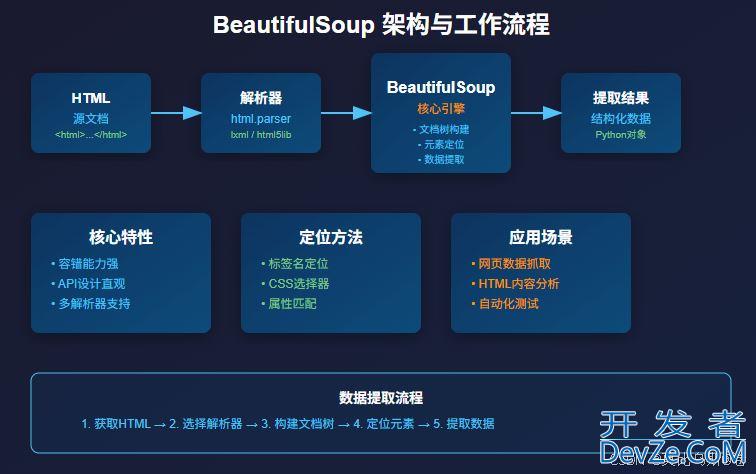
第一部分:BeautifulSoup核心概念解析
1.1 什么是BeautifulSoup?
BeautifulSoup是一个Python库,专门用于从HTML和XML文档中提取数据。它能够将复杂的HTML文档转换成一个复杂的树形结构,每个节点都是Python对象。
from bs4 import BeautifulSoup
import requests
# 获取网页内容
url = "https://example.com"
response = requests.get(url)
soup = BeautifulSoup(response.content, 'html.parser')
# 现在你可以像操作Python对象一样操作HTML
title = soup.title.text
print(f"网页标题:{title}")
1.2 BeautifulSoup的核心优势
1. 容错能力强
BeautifulSoup能够处理各种不规范的HTML,就像一个经验丰富的医生,即使面对"病症复杂"的网页也能准确诊断。2. API设计直观
它的语法设计非常人性化,读代码就像读英语一样自然。3. 解析器灵活
支持多种解析器,可以根据需求选择最合适的工具。第二部分:选择合适的解析器
2.1 解析器对比分析
BeautifulSoup支持多种解析器,每种都有其特点:
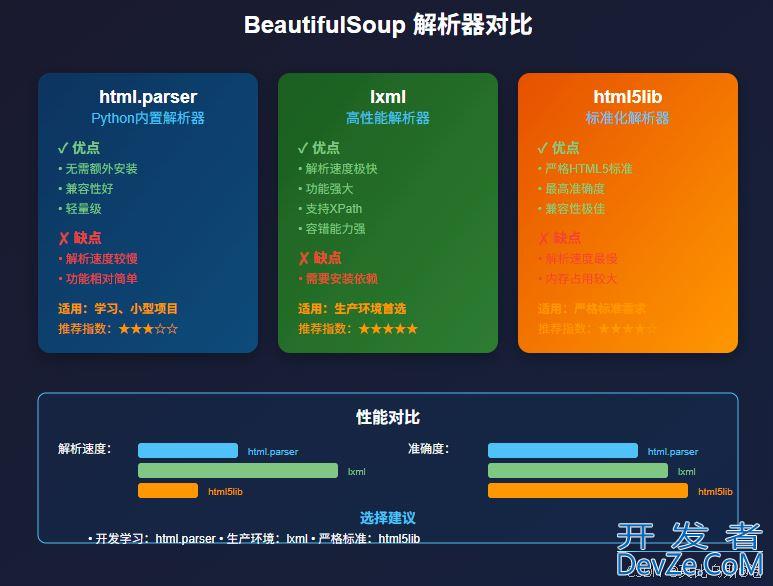
from bs4 import BeautifulSoup html_doc = """ <html> <head><title>测试页面</title></head> <body> <p class="story">这是一个段落</p> </body> </html> """ # Python内置解析器(推荐入门使用) soup1 = BeautifulSoup(html_doc, 'html.parser') # lxml解析器(推荐生产环境使用) soup2 = BeautifulSoup(html_doc, 'lxml') # html5lib解析器(最准确但最慢) soup3 = BeautifulSoup(html_doc, 'html5lib')
2.2 解析器选择建议
- 开发学习阶段:使用
html.parser,无需额外安装 - 生产环境:使用
lxml,速度快且功能强大 - 严格HTML5标准:使用
html5lib,准确度最高
第三部分:元素定位的艺术
3.1 基础定位方法
BeautifulSoup提供了多种定位元素的方法,就像GPS定位一样精准:
from bs4 import BeautifulSoup
html = """
<html>
<body>
<div class="container">
<h1 id="main-title">新闻标题</h1>
<p class="content">新闻内容第一段</p>
<p class="content">新闻内容第二段</p>
<a href="https://example.com" rel="external nofollow" class="link">相关链接</a>
GXsuzVA </div>
</body>
</html>
"""
soup = BeautifulSoup(html, 'html.parser')
# 1. 通过标签名定位
title = soup.h1
print(f"标题:{title.text}")
# 2. 通过ID定位
main_title = soup.find('h1', id='main-title')
print(f"主标题:{main_title.text}")
# 3. 通过类名定位
content_list = soup.find_all('p', class_='content')
for content in content_list:
print(f"内容:{content.text}")
# 4. 通过属性定位
link = soup.find('a', href='https://example.com')
print(f"链接文本:{link.text}")
print(f"链接地址:{link['href']}")
3.2 高级定位技巧
CSS选择器:精准制导
CSS选择器就像GPS坐标,能够精确定位到任何元素:
# CSS选择器示例
soup = BeautifulSoup(html, 'html.parser')
# 类选择器
contents = soup.select('.content')
# ID选择器
title = soup.select('#main-title')[0]
# 层级选择器
container_p = soup.select('div.container p')
# 属性选择器
external_links = soup.select('a[href^="http"]')
# 伪类选择器
first_p = soup.select('p:first-child')
正则表达式:模糊匹配
有时候我们需要进行模糊匹配,正则表达式就是最好的工具:
import re
# 使编程客栈用正则表达式匹配属性
email_links = soup.find_all('a', href=re.compile(r'mailto:'))
phone_numbers = soup.find_all(string=re.compile(r'\d{3}-\d{4}-\d{4}'))
第四部分:数据提取实战技巧
4.1 文本提取的艺术
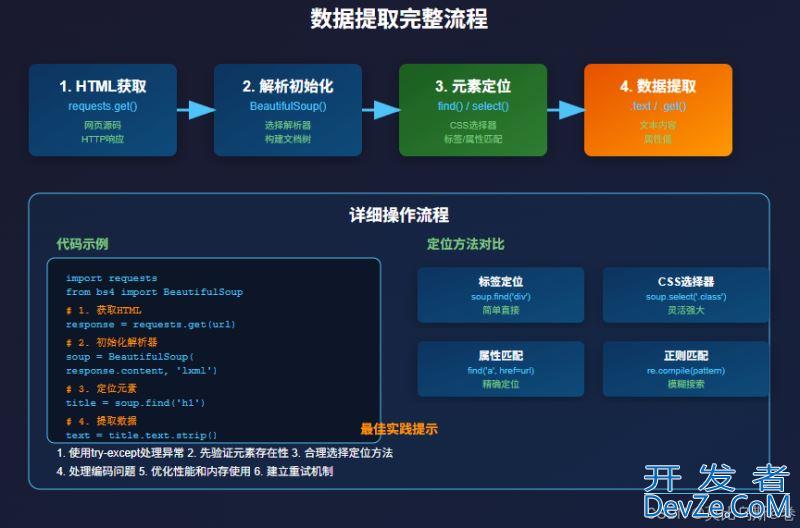
from bs4 import BeautifulSoup
import requests
def extract_news_data(url):
"""
新闻数据提取示例
"""
response = requests.get(url)
soup = BeautifulSoup(response.content, 'html.parser')
# 提取标题
title = soup.find('h1', class_='article-title')
title_text = title.text.strip() if title else "无标题"
# 提取发布时间
time_elem = soup.find('time')
publish_time = time_elem.get('datetime') if time_elem else "未知时间"
# 提取正文内容
content_divs = soup.find_all('div', class_='article-content')
content = '\n'.join([div.text.strip() for div in content_divs])
# 提取图片链接
images = []
for img in soup.find_all('img'):
src = img.get('src')
if src:
# 处理相对链接
if src.startswith('//'):
src = 'https:' + src
elif src.startswith('/'):
src = 'https://example.com' + src
images.append(src)
return {
'title': title_text,
'publish_time': publish_time,
'content': content,
'images': images
}
4.2 处理复杂HTML结构
实际的网页往往结构复杂,我们需要更加精细的处理:
def extract_product_info(html):
"""
电商产品信息提取示例
"""
soup = BeautifulSoup(html, 'html.parser')
product_info = {}
# 提取产品名称
name_elem = soup.find('h1', class_='product-name')
product_info['name'] = name_elem.text.strip() if name_elem else ""
# 提取价格(处理多种价格格式)
price_elem = soup.find('span', class_='price')
if price_elem:
price_text = price_elem.text
# 使用正则表达式提取数字
import re
price_match = re.search(r'[\d,]+\.?\d*', price_text)
product_info['price'] = float(price_match.group().replace(',', '')) if price_match else 0
# 提取产品参数
specs = {}
spec_table = soup.find('table', class_='specifications')
if spec_table:
for row in spec_table.find_all('tr'):
cells = row.find_all(['td', 'th'])
if len(cells) >= 2:
key = cells[0].text.strip()
value = cells[1].text.strip()
specs[key] = value
product_info['specifications'] = specs
# 提取评论数据
reviews = []
review_elements = soup.find_all('div', class_='review-item')
for review in review_elements:
rating_elem = review.find('span', class_='rating')
content_elem = review.find('p', class_='review-content')
if rating_elem and content_elem:
reviews.append({
'rating': len(rating_elem.find_all('span', class_='star-filled')),
'content': content_elem.text.strip()
})
product_info['reviews'] = reviews
return product_info
第五部分:高效数据处理技巧
5.1 批量处理与性能优化
当需要处理大量数据时,性能优化就变得至关重要:
import concurrent.futures
from typing import List, Dict
import time
class WebScraper:
def __init__(self, max_workers: int = 5):
self.max_workers = max_workers
self.session = requests.Session()
# 设置通用请求头
self.session.headers.update({
'User-Agent': 'Mozilla/5.0 (Windows NT 10.0; Win64; x64) AppleWebKit/537.36'
})
def fetch_single_page(self, url: str) -> Dict:
"""
获取单个页面数据
"""
try:
response = self.session.get(url, timeout=10)
response.raise_for_status()
soup = BeautifulSoup(response.content, 'lxml')
# 提取数据
return self.extract_page_data(soup, url)
except Exception as e:
print(f"处理 {url} 时出错: {e}")
return {'url': url, 'error': str(e)}
def extract_page_data(self, soup: BeautifulSoup, url: str) -> Dict:
"""
从soup对象中提取数据
"""
title = soup.find('title')
title_text = title.text.strip() if title else ""
# 提取所有链接
links = []
for link in soup.find_all('a', href=True):
href = link['href']
text = link.text.strip()
if href and text:
links.append({'url': href, 'text': text})
return {
'url': url,
'title': title_text,
'links': links,
编程客栈 'link_count': len(links)
}
def BATch_scrape(self, urls: List[str]) -> List[Dict]:
"""
批量抓取数据
"""
results = []
with concurrent.futures.ThreadPoolExecutor(max_workers=self.max_workers) as executor:
# 提交所有任务
future_to_url = {executor.submit(self.fetch_single_page, url): url for url in urls}
# 收集结果
for future in concurrent.futures.as_completed(future_to_url):
result = future.result()
results.append(result)
print(f"已完成: {result.get('url', 'Unknown')}")
return results
# 使用示例
scraper = WebScraper(max_workers=3)
urls = [
'https://example1.com',
'https://example2.com',
'https://example3.com'
]
results = scraper.batch_scrape(urls)
5.2 数据清洗与格式化
提取出的数据往往需要进一步清洗:
import re
from datetime import datetime
class DataCleaner:
@staticmethod
def clean_text(text: str) -> str:
"""
清洗文本数据
"""
if not text:
return ""
# 移除多余空白字符
text = re.sub(r'\s+', ' ', text)
# 移除HTML实体
text = text.replace(' ', ' ')
text = text.replace('<', '<')
text = text.replace('>', '>')
text = text.replace('&', '&')
return text.strip()
@staticmethod
def extract_numbers(text: str) -> List[float]:
"""
从文本中提取数字
"""
numbers = re.findall(r'\d+\.?\d*', text)
return [float(num) for num in numbers]
@staticmethod
def parse_date(date_string: str) -> datetime:
"""
解析各种日期格式
"""
date_patterns = [
'%Y-%m-%d',
'%Y/%m/%d',
'%d-%m-%Y',
'%d/%m/%Y',
编程客栈 '%Y-%m-%d %H:%M:%S'
]
for pattern in date_patterns:
try:
return datetime.strptime(date_string.strip(), pattern)
except ValueError:
continue
raise ValueError(f"无法解析日期: {date_string}")
# 使用示例
cleaner = DataCleaner()
# 清洗提取的数据
def process_scraped_data(raw_data: Dict) -> Dict:
"""
处理爬取的原始数据
"""
processed = {}
# 清洗标题
processed['title'] = cleaner.clean_text(raw_data.get('title', ''))
# 提取和清洗价格
price_text = raw_data.get('price_text', '')
prices = cleaner.extract_numbers(price_text)
processed['price'] = prices[0] if prices else 0.0
# 处理日期
date_text = raw_data.get('date', '')
try:
processed['date'] = cleaner.parse_date(date_text)
except ValueError:
processed['date'] = None
return processed
第六部分:实战项目案例
6.1 新闻聚合器
让我们构建一个完整的新闻聚合器:
import json
from dataclasses import dataclass
from typing import List
import SQLite3
@dataclass
class NewsArticle:
title: str
content: str
url: str
publish_time: str
source: str
tags: List[str]
class NewsAggregator:
def __init__(self, db_path: str = 'news.db'):
self.db_path = db_path
self.init_database()
def init_database(self):
"""
初始化数据库
"""
conn = sqlite3.connect(self.db_path)
cursor = conn.cursor()
cursor.execute('''
CREATE TABLE IF NOT EXISTS articles (
id INTEGER PRIMARY KEY AUTOINCREMENT,
title TEXT NOT NULL,
content TEXT,
url TEXT UNIQUE,
publish_time TEXT,
source TEXT,
tags TEXT,
created_at TIMESTAMP DEFAULT CURRENT_TIMESTAMP
)
''')
conn.commit()
conn.close()
def scrape_news_site(self, base_url: str, site_config: Dict) -> List[NewsArticle]:
"""
根据配置抓取新闻站点
"""
articles = []
try:
response = requests.get(base_url)
soup = BeautifulSoup(response.content, 'lxml')
# 根据配置提取文章链接
article_links = soup.select(site_config['article_selector'])
for link in article_links[:10]: # 限制抓取数量
article_url = link.get('href')
if not article_url.startswith('http'):
article_url = base_url + article_url
# 抓取具体文章
article = self.scrape_article(article_url, site_config)
if article:
articles.append(article)
# 避免请求过快
time.sleep(1)
except Exception as e:
print(f"抓取 {base_url} 失败: {e}")
return articles
def scrape_article(self, url: str, config: Dict) -> NewsArticle:
"""
抓取单篇文章
"""
try:
response = requests.get(url)
soup = BeautifulSoup(response.content, 'lxml')
# 提取标题
title_elem = soup.select_one(config['title_selector'])
title = title_elem.text.strip() if title_elem else ""
# 提取内容
content_elems = soup.select(config['content_selector'])
content = '\n'.join([elem.text.strip() for elem in content_elems])
# 提取发布时间
time_elem = soup.select_one(config.get('time_selector', ''))
publish_time = time_elem.text.strip() if time_elem else ""
# 提取标签
tag_elems = soup.select(config.get('tag_selector', ''))
tags = [tag.text.strip() for tag in tag_elems]
return NewsArticle(
title=title,
content=content,
javascript url=url,
publish_time=publish_time,
source=config['source_name'],
tags=tags
)
except Exception as e:
print(f"抓取文章 {url} 失败: {e}")
return None
def save_articles(self, articles: List[NewsArticle]):
"""
保存文章到数据库
"""
conn = sqlite3.connect(self.db_path)
cursor = conn.cursor()
for article in articles:
try:
cursor.execute('''
INSERT OR IGNORE INTO articles
(title, content, url, publish_time, source, tags)
VALUES (?, ?, ?, ?, ?, ?)
''', (
article.title,
article.content,
article.url,
article.publish_time,
article.source,
json.dumps(article.tags)
))
except Exception as e:
print(f"保存文章失败: {e}")
conn.commit()
conn.close()
# 使用示例
aggregator = NewsAggregator()
# 配置不同新闻站点
sites_config = {
'tech_news': {
'url': 'https://technews.example.com',
'source_name': '科技新闻',
'article_selector': 'a.article-link',
'title_selector': 'h1.article-title',
'content_selector': 'div.article-content p',
'time_selector': 'time.publish-time',
'tag_selector': 'span.tag'
}
}
# 抓取和保存新闻
for site_name, config in sites_config.items():
print(f"正在抓取 {site_name}...")
articles = aggregator.scrape_news_site(config['url'], config)
aggregator.save_articles(articles)
print(f"完成 {site_name},共抓取 {len(articles)} 篇文章")
6.2 错误处理与重试机制
在实际应用中,网络请求经常会失败,我们需要建立完善的错误处理机制:
import time
import random
from functools import wraps
def retry_on_failure(max_retries: int = 3, delay: float = 1.0):
"""
失败重试装饰器
"""
def decorator(func):
@wraps(func)
def wrapper(*args, **kwargs):
last_exception = None
for attempt in range(max_retries + 1):
try:
return func(*args, **kwargs)
except Exception as e:
last_exception = e
if attempt < max_retries:
wait_time = delay * (2 ** attempt) + random.uniform(0, 1)
print(f"第 {attempt + 1} 次尝试失败,{wait_time:.2f}秒后重试...")
time.sleep(wait_time)
else:
print(f"所有重试都失败了,最后的错误: {e}")
raise last_exception
return wrapper
return decorator
class RobustScraper:
def __init__(self):
self.session = requests.Session()
self.session.headers.update({
'User-Agent': 'Mozilla/5.0 (Windows NT 10.0; Win64; x64) AppleWebKit/537.36'
})
@retry_on_failure(max_retries=3, delay=1.0)
def fetch_page(self, url: str) -> BeautifulSoup:
"""
获取页面内容,带重试机制
"""
response = self.session.get(url, timeout=10)
response.raise_for_status()
if response.status_code == 200:
return BeautifulSoup(response.content, 'lxml')
else:
raise Exception(f"HTTP状态码: {response.status_code}")
def safe_extract_text(self, soup: BeautifulSoup, selector: str, default: str = "") -> str:
"""
安全地提取文本,避免元素不存在的错误
"""
try:
element = soup.select_one(selector)
return element.text.strip() if element else default
except Exception as e:
print(f"提取文本失败 ({selector}): {e}")
return default
def safe_extract_attr(self, soup: BeautifulSoup, selector: str, attr: str, default: str = "") -> str:
"""
安全地提取属性值
"""
try:
element = soup.select_one(selector)
return element.get(attr, default) if element else default
except Exception as e:
print(f"提取属性失败 ({selector}, {attr}): {e}")
return default
第七部分:性能优化与最佳实践
7.1 内存优化技巧
处理大量数据时,内存管理变得至关重要:
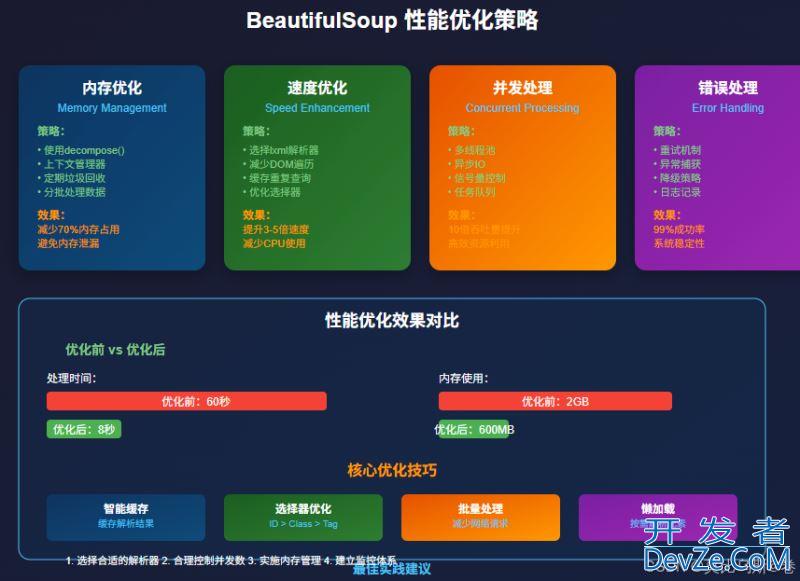
import gc
from contextlib import contextmanager
@contextmanager
def memory_efficient_parsing(html_content: str, parser: str = 'lxml'):
"""
内存高效的HTML解析上下文管理器
"""
soup = None
try:
soup = BeautifulSoup(html_content, parser)
yield soup
finally:
if soup:
soup.decompose() # 释放内存
del soup
gc.collect() # 强制垃圾回收
def process_large_html_file(file_path: str):
"""
处理大型HTML文件的示例
"""
with open(file_path, 'r', encoding='utf-8') as f:
html_content = f.read()
with memory_efficient_parsing(html_content) as soup:
# 只提取需要的数据
results = []
# 使用生成器避免一次性加载所有数据
for element in soup.find_all('div', class_='data-item'):
data = {
'id': element.get('id'),
'text': element.text.strip()
}
results.append(data)
# 定期清理已处理的元素
if len(results) % 1000 == 0:
element.decompose()
return results
7.2 并发处理优化
import asyncio
import aiohttp
from aiohttp import ClientSession
from bs4 import BeautifulSoup
class AsyncScraper:
def __init__(self, max_concurrent: int = 10):
self.max_concurrent = max_concurrent
self.semaphore = asyncio.Semaphore(max_concurrent)
async def fetch_page(self, session: ClientSession, url: str) -> Dict:
"""
异步获取页面
"""
async with self.semaphore:
try:
async with session.get(url) as response:
if response.status == 200:
html = await response.text()
return await self.parse_page(html, url)
else:
return {'url': url, 'error': f'HTTP {response.status}'}
except Exception as e:
return {'url': url, 'error': str(e)}
async def parse_page(self, html: str, url: str) -> Dict:
"""
异步解析页面(在线程池中运行)
"""
loop = asyncio.get_event_loop()
return await loop.run_in_executor(None, self._parse_html, html, url)
def _parse_html(self, html: str, url: str) -> Dict:
"""
同步HTML解析函数
"""
soup = BeautifulSoup(html, 'lxml')
title = soup.find('title')
title_text = title.text.strip() if title else ""
return {
'url': url,
'title': title_text,
'success': True
}
async def scrape_urls(self, urls: List[str]) -> List[Dict]:
"""
批量异步抓取URL
"""
async with aiohttp.ClientSession() as session:
tasks = [self.fetch_page(session, url) for url in urls]
results = await asyncio.gather(*tasks, return_exceptions=True)
# 处理异常结果
processed_results = []
for result in results:
if isinstance(result, Exception):
processed_results.append({'error': str(result)})
else:
processed_results.append(result)
return processed_results
# 使用示例
async def main():
scraper = AsyncScraper(max_concurrent=5)
urls = [f'https://example.com/page/{i}' for i in range(1, 21)]
results = await scraper.scrape_urls(urls)
successful = [r for r in results if r.get('success')]
failed = [r for r in results if 'error' in r]
print(f"成功: {len(successful)}, 失败: {len(failed)}")
# 运行异步代码
# asyncio.run(main())
第八部分:常见问题与解决方案
8.1 编码问题处理
import chardet
def smart_decode(content: bytes) -> str:
"""
智能解码HTML内容
"""
# 先尝试检测编码
detected = chardet.detect(content)
encoding = detected.get('encoding', 'utf-8')
try:
return content.decode(encoding)
except UnicodeDecodeError:
# 如果检测失败,尝试常见编码
encodings = ['utf-8', 'gbk', 'gb2312', 'big5', 'latin1']
for enc in encodings:
try:
return content.decode(enc)
except UnicodeDecodeError:
continue
# 最后使用错误处理
return content.decode('utf-8', errors='ignore')
# 使用示例
response = requests.get('https://example.com')
html_content = smart_decode(response.content)
soup = BeautifulSoup(html_content, 'lxml')
8.2 动态内容处理
有些网站使用JavaScript动态加载内容,BeautifulSoup无法直接处理:
from selenium import webdriver
from selenium.webdriver.common.by import By
from selenium.webdriver.support.ui import WebDriverWait
from selenium.webdriver.support import expected_conditions as EC
class DynamicContentScraper:
def __init__(self, headless: bool = True):
options = webdriver.ChromeOptions()
if headless:
options.add_argument('--headless')
options.add_argument('--no-sandbox')
options.add_argument('--disable-dev-shm-usage')
self.driver = webdriver.Chrome(options=options)
self.wait = WebDriverWait(self.driver, 10)
def scrape_dynamic_page(self, url: str) -> BeautifulSoup:
"""
抓取动态加载的页面
"""
self.driver.get(url)
# 等待特定元素加载完成
self.wait.until(
EC.presence_of_element_located((By.CLASS_NAME, "dynamic-content"))
)
# 获取完整的HTML
html = self.driver.page_source
return BeautifulSoup(html, 'lxml')
def close(self):
"""
关闭浏览器
"""
self.driver.quit()
# 使用示例
scraper = DynamicContentScraper()
try:
soup = scraper.scrape_dynamic_page('https://dynamic-example.com')
# 现在可以用BeautifulSoup处理动态加载的内容了
data = soup.find_all('div', class_='dynamic-content')
finally:
scraper.close()
结语:掌握BeautifulSoup的艺术
通过本文的学习,你已经掌握了BeautifulSoup的核心技能:
- 理解HTML解析的本质:从文档树结构到元素定位
- 掌握数据提取技巧:从基础选择器到高级CSS选择器
- 学会性能优化:从单线程到异步并发处理
- 建立最佳实践:从错误处理到内存管理
BeautifulSoup不仅仅是一个工具,更是一种思维方式。它教会我们如何系统化地分析和处理结构化数据,这种能力在数据科学、爬虫开发、自动化测试等多个领域都非常有价值。
记住,技术的掌握需要实践。建议你选择一个感兴趣的网站,运用本文介绍的技巧,构建自己的数据提取项目。在实践中遇到问题时,回头查阅本文的相关章节,相信你会有更深的理解。
最后,随着网络技术的发展,网页结构也在不断变化。保持学习的心态,关注新技术的发展,才能在数据提取的道路上走得更远。
以上就是Python使用BeautifulSoup提取网页数据的完整指南的详细内容,更多关于Python BeautifulSoup提取网页数据的资料请关注编程客栈(www.devze.com)其它相关文章!
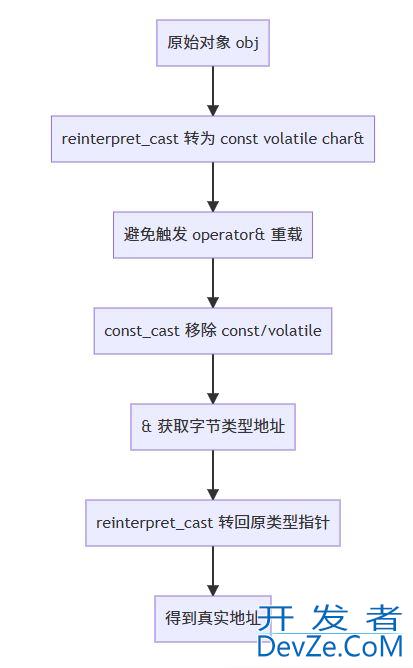





 加载中,请稍侯......
加载中,请稍侯......
精彩评论